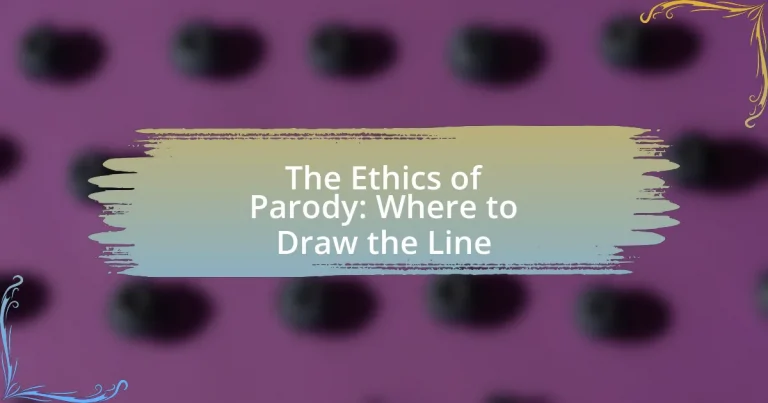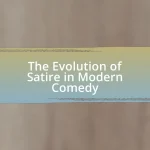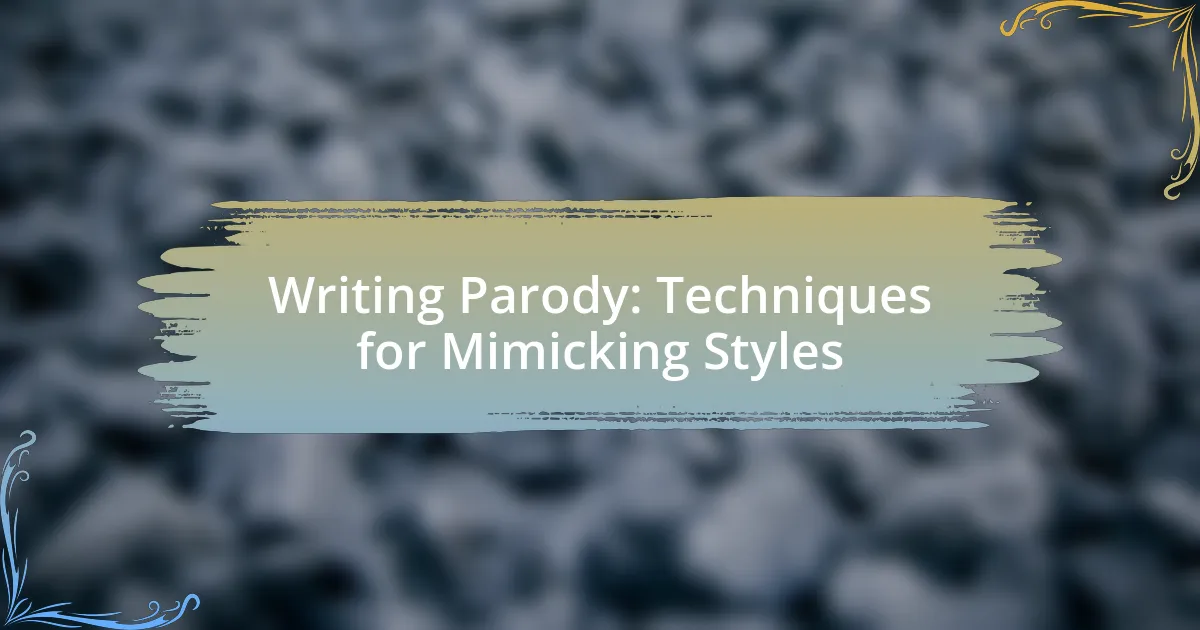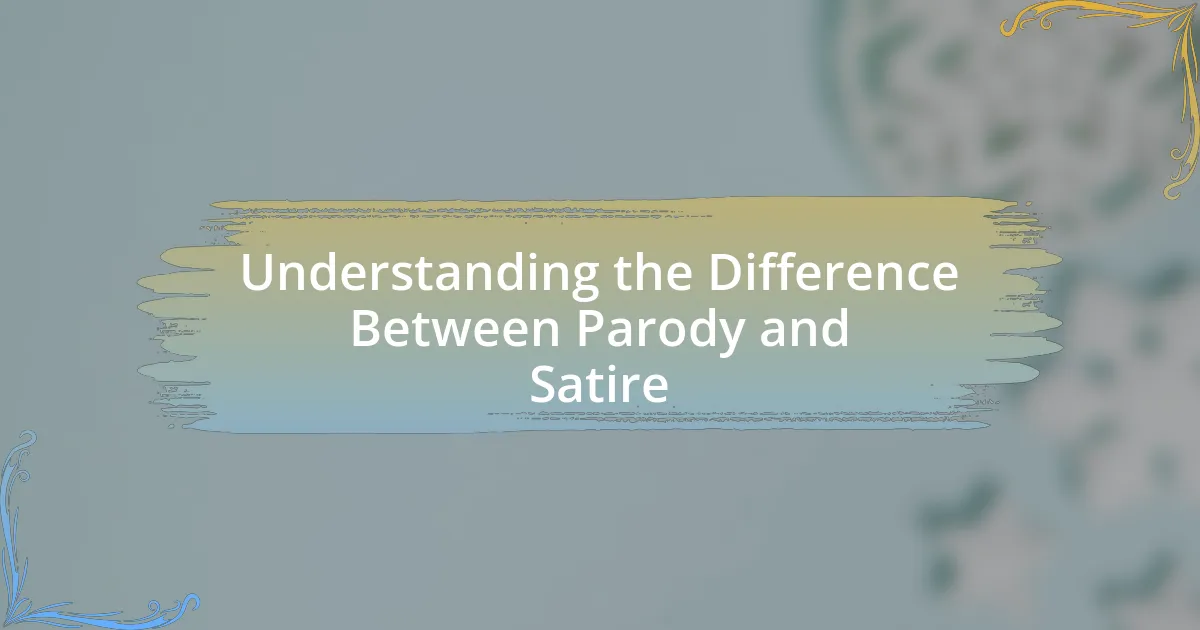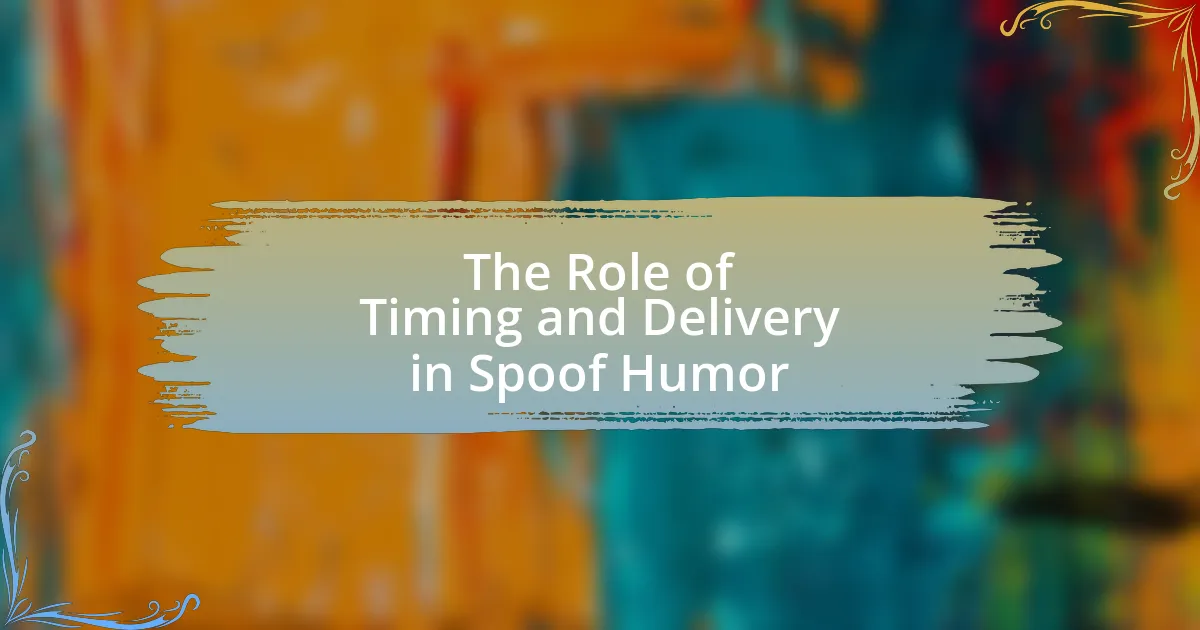The article examines the ethical considerations surrounding parody, focusing on issues such as copyright infringement, misrepresentation, and the impact on the original creator’s reputation. It differentiates parody from other forms of expression, emphasizing its intent to critique or humorously exaggerate original works. Legal standards for fair use in parody cases are outlined, highlighting the importance of transformative use and audience perception. The article also discusses the potential harms of parody, including the reinforcement of stereotypes and the risks of misinterpretation, while providing guidelines for creators to navigate ethical dilemmas and balance humor with respect.
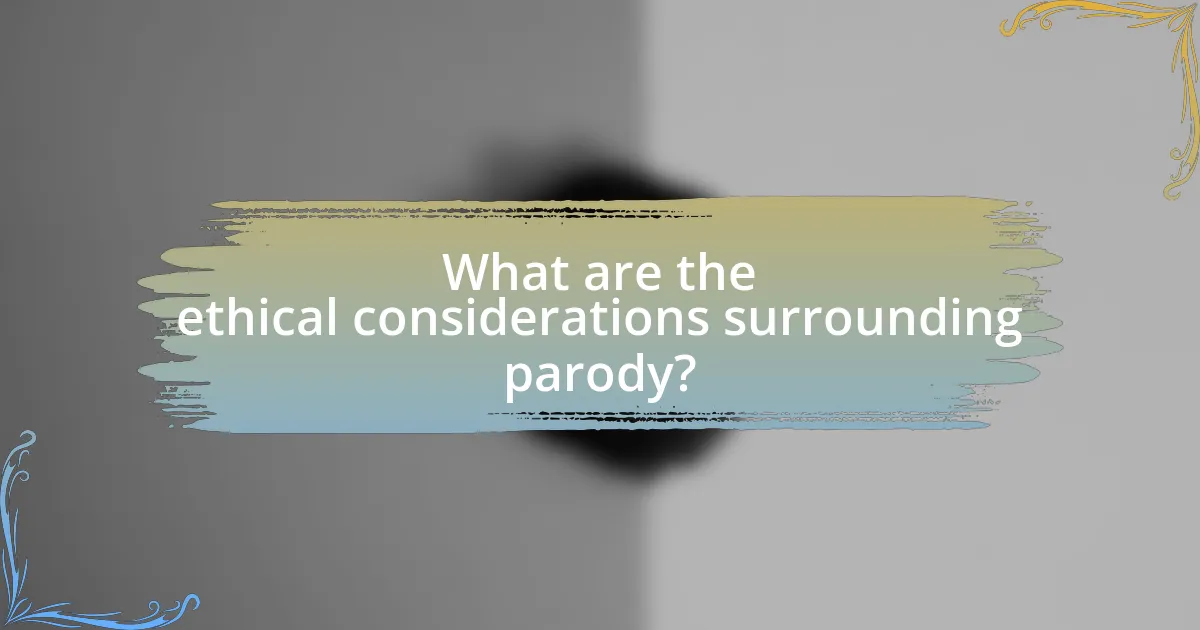
What are the ethical considerations surrounding parody?
The ethical considerations surrounding parody include issues of copyright infringement, the potential for misrepresentation, and the impact on the original creator’s reputation. Parody often relies on the original work for context, which raises questions about fair use; however, it must not confuse or mislead the audience regarding the original creator’s intent. Additionally, ethical concerns arise when parody could harm the original creator’s brand or message, especially if the parody is derogatory or offensive. Courts have recognized that while parody can be protected under fair use, it must balance the right to free expression with respect for the original work and its creator.
How does parody differ from other forms of expression?
Parody differs from other forms of expression primarily in its intent to imitate and exaggerate for comedic or critical effect. Unlike straightforward satire or commentary, parody specifically targets a particular work, genre, or style, often using humor to highlight its flaws or absurdities. For instance, the television show “Saturday Night Live” frequently parodies political figures and cultural phenomena, employing exaggeration to provoke thought and laughter. This distinct approach sets parody apart, as it relies on the audience’s familiarity with the original subject to create a humorous contrast, which is not a requirement for other forms of expression like traditional satire or straightforward critique.
What defines parody in a legal and cultural context?
Parody is defined in a legal context as a transformative work that imitates another work for comedic or critical effect, often protected under fair use doctrine. Legally, parody must comment on or critique the original work, distinguishing it from mere imitation or reproduction. In cultural terms, parody serves as a form of social commentary, allowing creators to engage with and critique societal norms, trends, or established works. The U.S. Supreme Court case Campbell v. Acuff-Rose Music, Inc. (1994) established that parody can qualify as fair use if it adds new expression or meaning, reinforcing its legal protection. Thus, parody operates at the intersection of legal standards and cultural expression, enabling both artistic freedom and critical discourse.
How does intent influence the ethical implications of parody?
Intent significantly influences the ethical implications of parody by determining whether the parody serves a purpose of critique or ridicule. When the intent is to comment on or critique the original work, it is often viewed as a legitimate form of expression protected under free speech, as seen in cases like “Campbell v. Acuff-Rose Music, Inc.” (1994), where the Supreme Court ruled that transformative use for commentary is fair use. Conversely, if the intent is to mislead or harm the original creator, the ethical implications shift towards potential infringement and harm, as it may exploit the original work without adding value or insight. Thus, the intent behind a parody shapes its ethical standing, influencing how it is perceived legally and socially.
Why is the concept of fair use important in parody?
The concept of fair use is important in parody because it allows creators to use existing works to comment on, criticize, or satirize those works without seeking permission from the original copyright holders. This legal doctrine is essential for fostering creativity and freedom of expression, as it enables artists to engage with cultural texts in a transformative way. For instance, the U.S. Supreme Court case Campbell v. Acuff-Rose Music, Inc. established that parody can qualify as fair use, emphasizing that the purpose and character of the use, including its transformative nature, are key factors in determining fair use. This ruling underscores the significance of fair use in protecting parodic works, which often rely on recognizable elements of the original to convey their message.
What are the legal standards for fair use in parody cases?
The legal standards for fair use in parody cases are primarily determined by the four-factor test established in the Copyright Act of 1976. This test evaluates the purpose and character of the use, the nature of the copyrighted work, the amount and substantiality of the portion used, and the effect of the use on the market for the original work. Parody is often considered transformative, as it adds new expression or meaning, which can favor fair use. Courts have upheld this in cases like Campbell v. Acuff-Rose Music, Inc., where the Supreme Court ruled that a commercial parody could qualify as fair use if it meets the criteria of the four-factor test.
How have courts interpreted fair use in relation to parody?
Courts have generally interpreted fair use in relation to parody as a permissible use of copyrighted material, provided that the parody comments on or critiques the original work. The landmark case, Campbell v. Acuff-Rose Music, Inc. (1994), established that a parody can qualify as fair use even if it is commercially motivated, emphasizing that the transformative nature of the work is crucial. The court determined that the parody must add new expression or meaning to the original, thus allowing for a balance between the rights of the original creator and the public interest in free expression.
What are the potential harms of parody?
Parody can potentially harm individuals and communities by perpetuating stereotypes, misrepresenting the original work, and causing emotional distress. Stereotypes reinforced through parody can lead to social stigmatization, as seen in instances where racial or gender-based caricatures are used, which can contribute to systemic discrimination. Misrepresentation occurs when the parody distorts the original message or intent, leading audiences to misunderstand the original work, as evidenced by parodies that take quotes or scenes out of context. Additionally, emotional distress can arise for individuals or groups targeted by parody, particularly if the content is derogatory or mocking, which can have real psychological effects, as noted in studies on the impact of humor on marginalized communities.
How can parody affect the original creator’s reputation?
Parody can significantly impact the original creator’s reputation by either enhancing or damaging it, depending on the context and reception of the parody. When a parody is humorous and well-received, it can elevate the original work’s visibility and popularity, as seen with “Weird Al” Yankovic’s parodies, which often lead to increased sales of the original songs. Conversely, if a parody is perceived as mocking or derogatory, it can tarnish the original creator’s image, as evidenced by negative reactions to parodies that misrepresent the original intent or message, such as the backlash faced by certain political cartoons. Thus, the effect of parody on reputation hinges on public perception and the nature of the parody itself.
What are the risks of misinterpretation in parody?
The risks of misinterpretation in parody include the potential for offense, distortion of the original message, and legal repercussions. When audiences misinterpret a parody, they may perceive it as an endorsement or criticism of the original work, leading to misunderstandings about the creator’s intent. For example, a parody that exaggerates certain traits of a public figure may be seen as a factual representation, which can damage reputations and relationships. Additionally, misinterpretation can result in copyright infringement claims if the parody is deemed to infringe on the original work’s rights. These risks highlight the importance of clarity in parody to ensure that the intended humor or critique is effectively communicated.
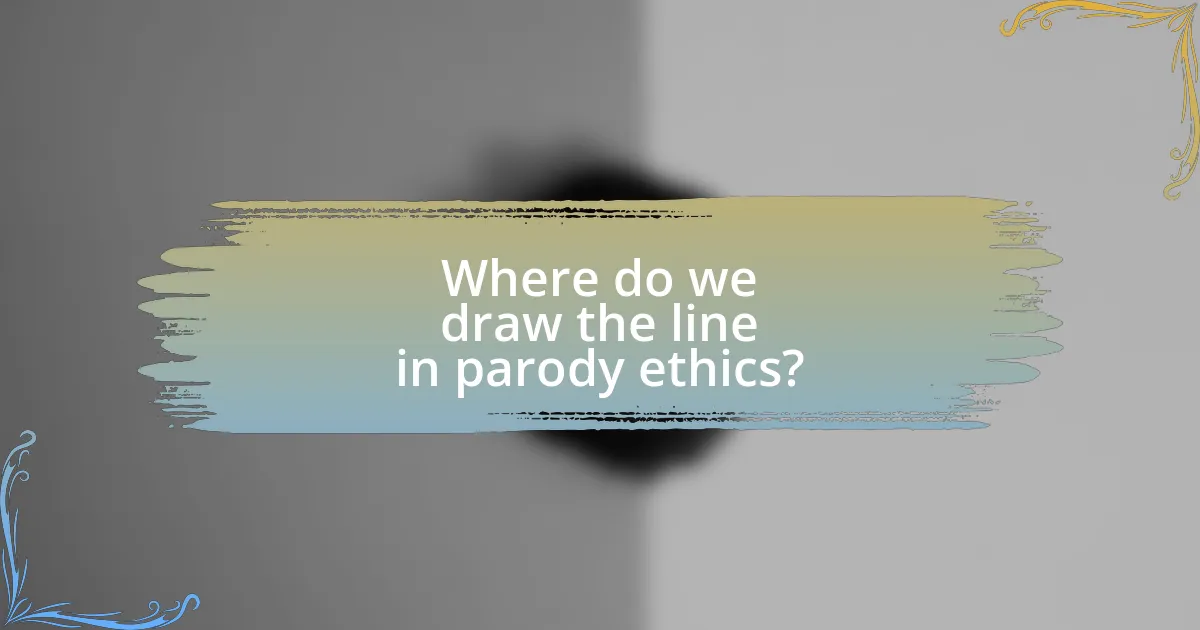
Where do we draw the line in parody ethics?
The line in parody ethics is drawn at the point where the parody ceases to be transformative and begins to infringe upon the original work’s market or reputation. Parody is protected under fair use in many jurisdictions, provided it comments on or critiques the original work, as established in the U.S. Supreme Court case Campbell v. Acuff-Rose Music, Inc. (1994), which affirmed that transformative use is a key factor in determining fair use. When a parody misleads consumers or causes confusion regarding the source or sponsorship of the original work, it may cross ethical boundaries, as it can harm the original creator’s interests.
What factors should be considered when evaluating a parody?
When evaluating a parody, key factors include the intent of the creator, the degree of transformation from the original work, and the potential for confusion among audiences. The creator’s intent is crucial as it determines whether the parody aims to critique, entertain, or simply mimic the original. The degree of transformation assesses how much the parody alters the original content, which can influence its classification as fair use. Additionally, the potential for audience confusion is significant; if the parody misleads viewers into thinking it is the original work, it may raise ethical concerns. These factors collectively help in determining the legality and ethical implications of the parody in question.
How does the target of the parody influence its ethical standing?
The target of the parody significantly influences its ethical standing by determining whether the parody serves a constructive purpose or perpetuates harm. When the target is a public figure or institution, the ethical implications may lean towards freedom of expression and social critique, as seen in political cartoons that challenge authority. Conversely, if the target is a marginalized group, the ethical standing may be compromised, as it risks reinforcing stereotypes or causing emotional distress. For instance, parodies that mock individuals based on race or gender can be deemed unethical due to their potential to perpetuate discrimination. Thus, the nature of the target directly impacts the ethical evaluation of the parody.
What role does audience perception play in determining ethical boundaries?
Audience perception significantly influences the establishment of ethical boundaries by shaping societal norms and expectations regarding acceptable behavior. When audiences react positively or negatively to a particular action or expression, such as parody, they signal what is deemed ethical or unethical within that context. For instance, a study by the Pew Research Center found that 70% of respondents believe that public opinion should guide ethical standards in media, indicating that audience sentiment directly impacts the ethical landscape. Thus, the collective perception of an audience serves as a barometer for determining the limits of ethical conduct, particularly in creative expressions like parody.
How can creators navigate ethical dilemmas in parody?
Creators can navigate ethical dilemmas in parody by ensuring that their work is transformative, clearly distinguishes itself from the original, and respects the rights of the original creators. Transformative use is a key factor in fair use doctrine, which allows for parody as long as it adds new expression or meaning. For instance, the U.S. Supreme Court case Campbell v. Acuff-Rose Music, Inc. established that a parody can qualify as fair use if it comments on or criticizes the original work. Additionally, creators should consider the potential harm their parody may cause to the original work’s market or reputation, as this can influence the ethical implications of their creation. By adhering to these principles, creators can mitigate ethical concerns while engaging in parody.
What guidelines can help ensure ethical parody creation?
To ensure ethical parody creation, creators should adhere to guidelines that respect the original work while maintaining transformative elements. First, the parody must clearly comment on or critique the original work, establishing a distinct purpose that differentiates it from mere imitation. Second, creators should avoid using excessive portions of the original material, focusing instead on what is necessary to convey the parody’s message. Third, creators must consider the potential for market confusion; if the parody could be mistaken for the original, it may infringe on the original creator’s rights. Additionally, creators should acknowledge the original work and its creator, fostering transparency and respect. These guidelines align with legal standards, such as the fair use doctrine in the United States, which permits limited use of copyrighted material for purposes like criticism and commentary.
How can feedback from audiences shape ethical parody practices?
Feedback from audiences can significantly shape ethical parody practices by providing insights into public perception and cultural sensitivities. When audiences express their reactions to a parody, creators can gauge whether the content is perceived as humorous or offensive, thus informing future works. For instance, the backlash against certain parodies that were deemed disrespectful or harmful has led creators to reconsider their approaches, ensuring that they respect the original work and the communities involved. This dynamic interaction fosters a more responsible creative environment, as seen in cases where audience feedback prompted changes in content to avoid perpetuating stereotypes or misinformation.
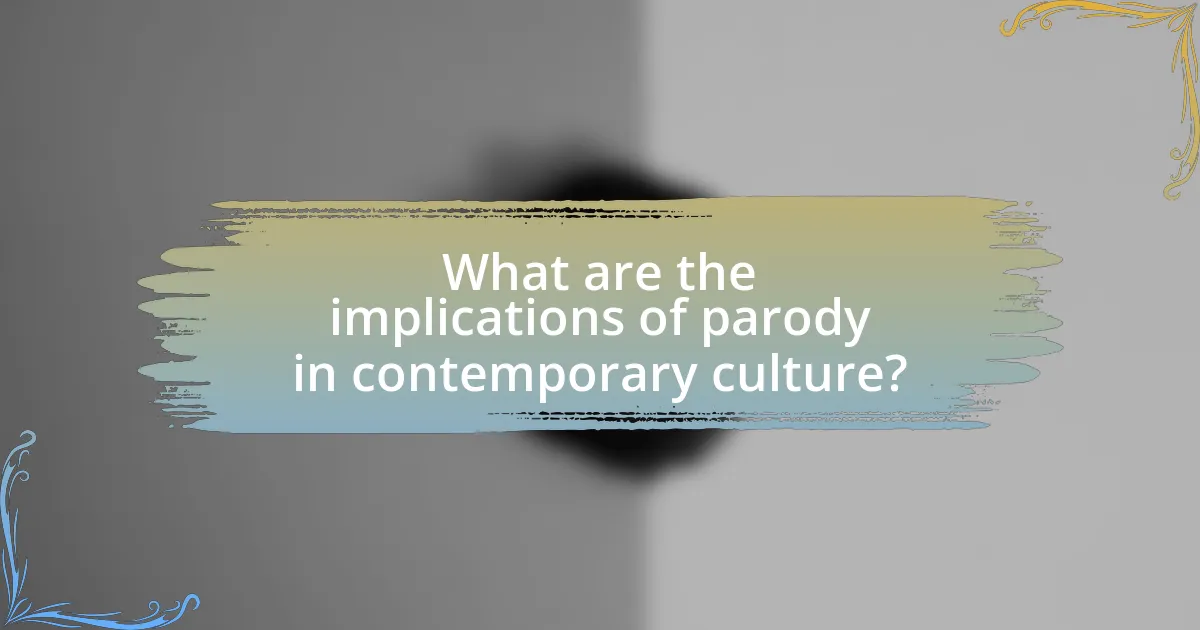
What are the implications of parody in contemporary culture?
Parody in contemporary culture serves as a critical tool for social commentary and cultural critique. It allows creators to challenge societal norms, question authority, and highlight absurdities within various contexts, such as politics, media, and popular culture. For instance, shows like “Saturday Night Live” and platforms like “The Onion” utilize parody to provoke thought and discussion about current events, often leading to increased public awareness and engagement. This form of expression can also blur the lines between homage and infringement, raising ethical questions about intellectual property and the rights of original creators. The implications of parody thus encompass both its role in fostering dialogue and the potential legal and moral dilemmas it presents in contemporary society.
How does parody contribute to social commentary?
Parody contributes to social commentary by using humor and exaggeration to critique societal norms, behaviors, and institutions. This form of expression allows creators to highlight absurdities and contradictions within culture, making complex issues more accessible and engaging for audiences. For instance, television shows like “Saturday Night Live” and films such as “Dr. Strangelove” effectively use parody to address political and social issues, prompting viewers to reflect on the underlying realities. By distorting familiar subjects, parody encourages critical thinking and discussion, ultimately fostering a deeper understanding of societal dynamics.
What examples illustrate the impact of parody on public discourse?
Parody significantly impacts public discourse by shaping perceptions and influencing societal conversations. For instance, “Saturday Night Live” has used political parody to critique and satirize presidential candidates, notably during the 2016 election, where Alec Baldwin’s portrayal of Donald Trump sparked widespread discussion and engagement among viewers. Additionally, the web series “The Onion” employs parody to comment on current events, often highlighting absurdities in news coverage, which encourages audiences to question the reliability of media sources. These examples demonstrate how parody can provoke thought, challenge authority, and stimulate dialogue within society.
How can parody serve as a tool for activism?
Parody serves as a tool for activism by using humor and satire to critique social and political issues, making complex topics more accessible and engaging to a broader audience. This method can effectively highlight injustices, challenge authority, and provoke thought, as seen in works like “The Onion” or “Saturday Night Live,” which often address current events through parody. Research indicates that humor can enhance message retention and encourage discussions, making it a powerful medium for raising awareness and inspiring action among diverse groups.
What are the best practices for creating ethical parody?
The best practices for creating ethical parody include ensuring that the parody is transformative, does not mislead the audience, and respects the original creator’s rights. Transformative use means that the parody adds new expression or meaning, distinguishing it from the original work, which is supported by the fair use doctrine in copyright law. Additionally, ethical parodies should clearly indicate their satirical intent to avoid confusion, thereby preventing any potential harm to the original creator’s reputation. Respecting the original creator’s rights involves avoiding derogatory or harmful portrayals that could damage their image or brand. These practices help maintain a balance between creative expression and ethical responsibility in parody.
How can creators balance humor and respect in their work?
Creators can balance humor and respect in their work by understanding their audience and the context of their content. This involves being aware of cultural sensitivities and avoiding stereotypes that could offend marginalized groups. For instance, successful comedians often test their material with diverse audiences to gauge reactions, ensuring that humor does not come at the expense of respect. Research indicates that humor that fosters inclusivity and empathy tends to resonate better, as seen in studies by the University of California, which found that humor can enhance social bonds when it is considerate rather than derogatory. By prioritizing empathy and awareness, creators can effectively blend humor with respect.
What resources are available for understanding parody ethics?
Resources available for understanding parody ethics include academic articles, legal analyses, and books focused on intellectual property and freedom of expression. Notable works include “The Parody Exception: A Comparative Study” by David L. Hudson Jr., which examines legal frameworks surrounding parody in various jurisdictions, and “Copyright Law: A Handbook for Writers” by Stephen Fishman, which provides insights into how parody is treated under copyright law. Additionally, the Stanford Law Review often publishes articles discussing the implications of parody in legal contexts, providing a scholarly perspective on ethical considerations. These resources collectively offer a comprehensive understanding of the ethical boundaries and legal protections associated with parody.
